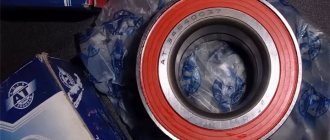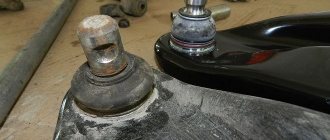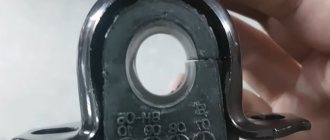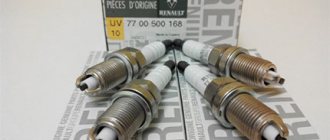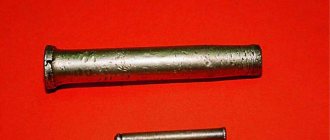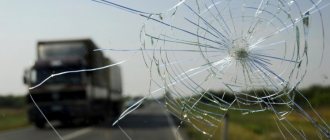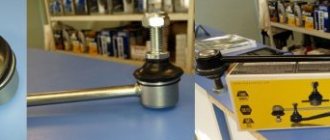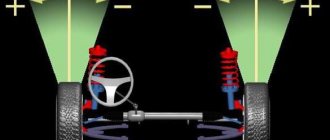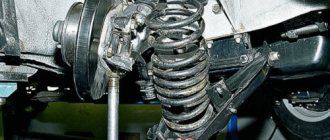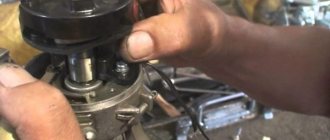Stabilizer bushings. Signs of malfunction. Consequences.
For the best damping of vibration and force impacts on the car body, the vast majority of suspension elements are connected by means of elastic elements.
The same applies to the stabilizer. To secure it, special bushings (rubber bands, cushions) made of durable rubber or polyurethane are used. Over time, as the vehicle is used, these bushings may begin to deteriorate and noticeably lose their elasticity. The result of this is unsatisfactory operation of the stabilizer =. More serious defects may begin to appear, which will only grow faster over time. The first symptom indicating replacement of the bushings will be a slight knocking sound from the suspension. A similar knock can be observed with “tired” shock absorbers. Only in the case of bushings it will be heard not only on potholes and potholes, but also when entering relatively sharp turns. At the same time, the car often feels excessively rolly and sluggish. The knocking sound that appears will be a consequence of play that has arisen in the connecting nodes of the stabilizer arms due to worn bushings.
If measures are not taken in time, the knocking will only intensify in the future and will begin to accompany the operation of the suspension everywhere due to increasing deformation and destruction of the bushings. Body roll and excessive play in the steering wheel may occur. The car may “yaw” not only when turning, but also when braking or changing lanes. Most car manufacturers recommend changing stabilizer bushings every 30–40 thousand mileage. However, in our conditions it is better to focus on bushing wear. Therefore, a sudden knocking sound and slight rattling in corners will be clear signs of an impending component replacement.
As a popular method of checking the bushings for serviceability, it is proposed to drive the speed bump diagonally in 2nd gear. A dull knock appeared in the area of the pedals - most likely due to the hub bushings. You can also just crawl under the car and inspect everything yourself. A worn bushing will be pleased with the presence of cracks and abrasions characteristic of worn and cracked rubber. Auto mechanics sometimes also call these cracks “daisies.”
Also, the rubber of the bushings can simply harden and lose the necessary elasticity. If you can’t get a good look at the stabilizer bushings, just swing your hand strongly up and down and to the sides on the stabilizer itself. If you feel play, creaks and knocks in the lower part of the suspension, it means that the bushings have become unusable.
But for the best results, it is, of course, better to drive onto an overpass, an inspection hole, or use a lift. The only tools you will need are a crowbar or a mounting spade, which you simply need to rest against the bottom of the car and slightly “shake” the stabilizer where it connects to the body. If you feel noticeable play or loss of elasticity, then it’s time to think about replacing the bushings.
Anti-roll bar
But there is one more important detail in the suspension, without which no modern car can do. And this part is a stabilizer. It can be easily seen if the car is driven onto a lift or placed on a viewing hole. On the front axle, among the springs, shock absorbers and other levers, you will easily notice a curved steel rod, which is attached to the subframe with one arm and to the wheel hub with the other. The stabilizer mounts are not rigid and allow it to move along the axis in one plane.
The stabilizer appeared in the suspension design at the dawn of the automotive industry, when speeds began to reach 20 km/h and above. The introduction of this element into the suspension design made it possible to ensure that the vehicle remains stable when cornering and maneuvering.
Thus, the main task of the stabilizer during movement is to distribute the weight of the car body over all its wheels in the event of a roll. In particular, this applies to cases of fairly sharp turns or when there is a sudden change in the trajectory of movement.
The principle of operation of the anti-roll bar
On the McFerson type of suspension, which is quite common today, the stabilizer is a torsion bar that acts on torsion. This element is rigidly connected to the car body or subframe. The forces generated in the suspension are transmitted to the stabilizer through additional levers, which communicate with the suspension through hinges. This simple scheme allows you to prevent even a serious roll of the vehicle, and even more so, its rollover.
The rear axle is most often equipped with a stabilizer of this type if the vehicle has all-wheel drive. If we talk about cars with rear-wheel drive and a solid beam on the rear axle, then the role of the stabilizer is given to the reaction bar, also known as the Panhard rod.
Also, a number of Japanese off-road vehicles at one time, in addition to the Panhard rod, were additionally equipped with another stabilizer, which, in the form of a curved rod, ran along the rear axle beam and communicated with the power components of the body through small levers.
Benefits of timely replacement
Every driver can cope with replacing bushings on his car, because this process is not a very complicated repair. You can do everything yourself, but if you don’t have the time or desire, then it is advisable to seek help from specialists. This will protect the stabilizer bar links from premature wear.
Driving on poor-quality road surfaces will fade into the background if you have previously installed new bushings. And in general, installed new bushings mean the absence of difficulties and problems when moving, as well as comfort and safety.
Smooth road to everyone: how and why to change stabilizer bushings
No need to heel!
If cars always drove in a straight line, and did not accelerate or brake, a stabilizer would not be needed at all.
Its work begins every time the car tries to tilt. Whether it's lateral roll when turning or longitudinal roll when braking, the stabilizer tries to keep the body parallel to the road surface. And despite the elementary design, he does it well. The stabilizer is just a rod connecting the subframe to the wheel mount (today we will talk about the MacPherson front suspension, so let’s put it more simply - with the suspension arm). It should be noted that MacPherson really, really needs the use of a stabilizer, mainly due to some compromise in the design. The camber angle there is static, but during roll it changes due to the peculiarities of the suspension design. Why is this bad? Because changing camber angles inevitably reduces the area of contact between the tire and the road. And the only way to avoid this phenomenon is to reduce the roll. This is where the stabilizer, which works like a torsion bar, helps: with a lateral roll, the opposite ends, fixed in the levers, begin to move in different directions, twisting the middle part. The resulting moment prevents further relative movement of the wheels, reducing roll. As you can see, it works very simply.
Articles / Practice Let's burn like a child: how and why to change rear suspension silent blocks Often the word “silent block” written on the Internet makes you want to pick up a drill and drill out your eyes. No matter how they write it, the “salenblock” option is the most common. We see... 51572 1 2 12/19/2016
But in order not to become a fan of the cult of the stabilizer, it is necessary to say a few words about its shortcomings. Firstly, the stabilizer willy-nilly reduces the suspension travel. Of course, this is not critical for a passenger car, but for an SUV it can be harmful. Well, secondly, you shouldn’t get carried away with replacing the stabilizer with something more rigid, which some car owners sometimes like to do. In their opinion, a more durable stabilizer will help to almost completely avoid rolls and turn the Zhiguli into a Formula 1 car. This is a very dangerous misconception.
The first thing Kulibin will encounter with an arm-thick piece of iron in the front suspension is an unexpectedly easy drift due to an unhealthy imbalance of the grip of the front and rear wheels with the road (it will be insufficient for the rear wheels). It must be understood that the engineers who developed the suspensions carefully calculated not only each of the suspensions, but also their joint work. And if you incorrectly interfere with the operation of one of them, the overall controllability will decrease, although the roll, quite possibly, will become a little less.
So, what does the bushings have to do with it, and why change them? As I already said, the stabilizer must be able to twist from multidirectional forces on the right and left wheels. If it is welded or rigidly attached to the subframe in any other way, it will be deprived of this opportunity, which is why it is attached to it using bushings. Over time, they wear out, and the stabilizer begins to “walk” in them.
This play, like any other, increases the degrees of freedom of the part, which nullify all its ability to prevent roll. And then, when cornering, the car begins to lean on its side more than it should.
Not every car enthusiast will immediately notice this, so they change the bushings in other cases: if wear is detected during suspension diagnostics, or if it is already starting to knock. However, the second situation is usually more typical not due to physical wear, but due to a good impact or other mechanical impact.
So, we have come to understand that bushings must be replaced periodically, and this is completely normal. Let's see how to do this.
What will you need?
What's great about this renovation is that it's inexpensive. And I would even say that there is no point in doing it with your own hands, no matter how skillful they may be. Therefore, let's go to the service center and just watch how a specialist does it.
You will need a minimum of tools: an 18 mm socket and a 10 mm wrench (or socket). But look at the wrench: why has life crippled it so much? In fact, what we have in front of us is not just a key, but the Modernized Special Tool of Alexey Teleshov, we will call it that.
Since we will be changing the bushings on Logan, we will have to take into account some of its features, so such a tricky key may come in handy. In addition, you will have to look for a lift, and quite possibly a hydraulic strut (we used it, in any case) along with an angle grinder. So, despite the apparent simplicity, everything is not so simple.
Now about the cost of spare parts. There is no point in chasing the original, there are very worthy manufacturers, especially since the bushing is a piece of elastic, and it is not so difficult to do something there. Therefore, we pay attention to two popular models: the French Sasic for 160 rubles and the Belgian Sidem for 180. We will choose Sasic.
We go into the box and get on the lift.
As usually happens with threaded connections at the bottom of the machine, they have all long since become covered with a layer of dirt and have become sour. Therefore, before starting work, it makes sense to pour WD40 on the bolts. We wait a little and pull out into the light that same key with a broken fate and try to unscrew the ten bolt from above (seen in the photo).
Naturally, this is as useless as asking a cat to quickly walk through an open door (if you have a cat, you will understand the futility of the plan). But in this case, the design of the Logan suspension itself helps us: this bolt is usually simply cut off, because its purpose is unclear to anyone, even in the heavier and off-road Duster this unit is made simpler and a little more gentle (and the bolt has a smaller diameter). Therefore, the specialist draws a mark with a white marker at which it will be necessary to cut off the ear of the clamp. Now it’s up to the “grinder”: cut off this ear and move to the other side.
1 / 3
2 / 3
3 / 3
Here the matter is complicated by the dangerous proximity of the clamp to the fuel pipes. They will have to be removed. This is easy to do: unscrew the nearest bolt protecting the oil pan, after which the tubes can be pulled out of the clamps and moved to the side. To keep them out of the way, they can be secured with a hook made of any fairly stiff wire. But all this will have to be done only if the eye has to be cut off on this side as well - for some reason the bolt here came off easily.
1 / 3
2 / 3
3 / 3
Now remove the clamp. We unscrew the only fixing bolt with a head. Removing the clamp is not so easy, so we take the mounting bracket and hook it to the hole of this bolt. That's it, the clamp is in our hands. Now, using the same installation, we remove the stabilizer from the subframe and take out the bushing. Just for fun, let's compare the new and old bushings. The part we just removed shows wear, but it is not critical yet. A completely dead bushing has a well-defined ovality. But once we start making changes, we do the work until the end.
1 / 4
2 / 4
3 / 4
4 / 4
We take the assembly again and again move the stabilizer away from the subframe. We insert the sleeve, after which the mounting can be removed. To make it easier to install the clamp, we use grease (we used copper). We apply it to both the clamp and the bolt.
1 / 4
2 / 4
3 / 4
4 / 4
This is necessary so that, firstly, it is easier to put on the clamp, and secondly, it is easier to unscrew the bolt next time. It is not always possible to press the clamp into place by hand. I would even say that it always doesn’t work out. Hitting the rubber with a hammer is usually useless, so we drag a hydraulic strut under the car. We rest it against the clamp and lift it slightly. If everything is assembled correctly (although what could be assembled incorrectly?), then the holes on the clamp and the subframe will coincide, and all we have to do is tighten the bolt and then tighten it to the end.
1 / 3
2 / 3
3 / 3
Articles / Practice Quietly and quickly: how and why to change gears in a manual transmission There was a time when three forward gears in a manual transmission were enough for car enthusiasts to move comfortably. But then four of them appeared, and now there have never been fewer than five... 22899 0 7 12/05/2016
It happens that the clamp does not want to go into place. In this case, you should not try to pull it onto the bushing with excessive force: it can be damaged or deformed and simply tighten it crookedly. It will turn out even worse than it was, because the stabilizer is equally contraindicated by excessive play and too tight a position, when it cannot work as a torsion bar. Most likely, the problem is insufficient lubrication - without it, friction between the iron of the clamp and the rubber of the bushing will not allow the part to be installed correctly and without unnecessary effort. Add a little of it and everything will go much easier.
And now we repeat exactly the same operation on the other side, not forgetting to return the fuel pipes to their place and tighten the protection bolt if they still had to be removed. That's all.
What's the result?
In principle, there are no fundamental differences on other cars with MacPherson front suspension. And there is hardly anything difficult in this work, if not for the use of a lift and some other tools to deal with soured bolts.
Work in the service would cost 440 rubles per side. Inexpensive, but you can try to make it yourself. There is a beauty here: if something goes wrong, you can carefully drive to the service station without a stabilizer at all, and then everything will be put back together as expected. Well, maybe they will laugh, but this will happen in your absence.
It will be much worse to continue driving with broken or worn bushings. Even if there is no knocking at the bottom (and at first there will definitely be nothing knocking), the controllability will decrease, sometimes even to the point of disgrace. There is no point in bringing it to this point; every turn will be much more dangerous than it actually is.
For assistance in preparing the material, we thank the network of specialized stores and car services “Logan-Shop” (St. Petersburg, Shkolnaya St., 73/2, tel: 928-32-20)
Survey
Have you ever had a stabilizer bar?
Your voice
Total votes:
Replacing the Kia stabilizer bushing
Replacing the Kia stabilizer bushings involves the following algorithm: • Raise the front of the car and remove the wheels. Find the steering shaft and make a mark (for easy further installation in the original place), remove the mounting bolt. • Using a jack, lift the gearbox, unscrew the rear cushion and subframe. • To simplify access to the rear cushions, four bolts are removed to secure the subframe. • Raise the front part of the subframe using a jack. • Remove the fastening and treat it with an oil solution to prevent the development of corrosion processes on the metal. • Screw them into place only four to five turns.
This is done crosswise to provide additional security and uniform tightening of the plane. • Loosen the jack to a level where you can reach the bushing bolts. • The bushing on the right side can be easily unscrewed through the engine compartment, and on the left side - from below. • Insert staples. This procedure is carried out in a careful manner so as not to damage the clamp on the steering boot. • The process is repeated in reverse order. The peculiarity of the Kia Sid car is that the steering shaft has a telescopic appearance, and therefore its installation occurs at the last moment.
How to replace front and rear stabilizer bushings?
Anti-roll bar bushings are an integral element of the system that ensures lateral stability of the vehicle in corners. During a turn, centrifugal force tends to tilt the body in the opposite direction, and the stabilizer torsion bar, attached to the body and suspension using bushings, resists this influence. Over time, bushings wear out, break down and become unusable, after which they must be replaced. We will talk about how to determine whether bushings require replacement and how to change them.
The following types of bushings exist:
1. Spherical (or “iron”) bushing. The design resembles a ball joint;
2. Rubber bushing.
Today, polyurethane type stabilizer bushings are becoming increasingly popular. They are quite easy to replace, which is an important advantage, and they also have good operating characteristics. Experienced drivers can safely say that these are the parts that are most convenient.
If a malfunction occurs in the area of the stabilizer bushing , it must be replaced without fail. Otherwise, this can have a very bad effect on the performance and handling of the vehicle. When the bushing is deformed or cracks appear on it, some noise may appear in the area of the car suspension (mainly when the car hits an obstacle or increases speed). In principle, problems in the suspension area are identified precisely by such noise.
In order to make sure that it is necessary to replace the bushings, periodically it is necessary to carry out diagnostics of the suspension, after which the malfunction will be identified or prevented.
In the event that it is determined that it is necessary to replace the stabilizer bushing, this can be done independently. Moreover, there is nothing complicated about it and the procedure is very simple. First, the bolts with which the clamp is attached are unscrewed. Then the stabilizer is moved to the side and the old parts are removed. Well, for the final action, the new part is installed very carefully.
It is according to this scheme that both the front stabilizer and the rear stabilizer are replaced . After replacing spare parts, driving a car will be much more pleasant and comfortable, and various kinds of road obstacles will be overcome without any difficulties. Among other things, the new elements will maximize the performance of the racks.

